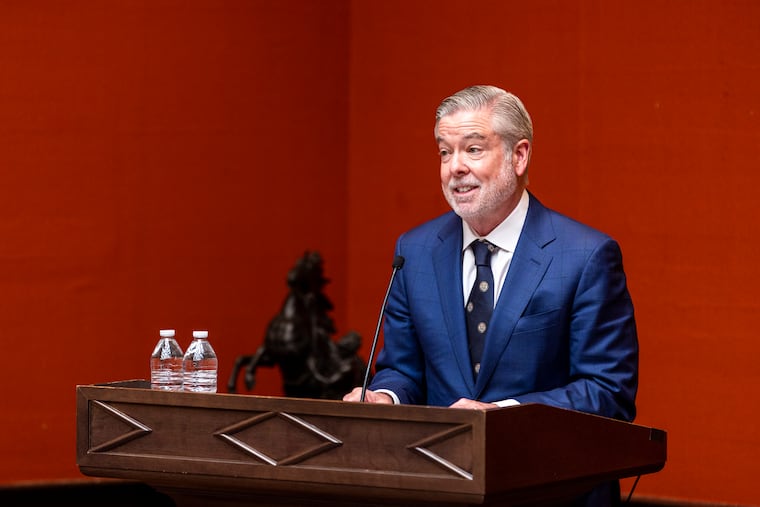Would John Fry try to kill Temple football? He wrote an op-ed that may offer some hints.
In a 2016 Wall Street Journal piece, the prospective Temple president wrote that Drexel was not "burdened by the distractions that come with maintaining a football program."

This article was updated to better reflect Stan Drayton’s salary.
Financial losses from collegiate athletics “force universities to divert funding from the fundamental task of educating students,” John Fry wrote in a Wall Street Journal op-ed in 2016.
The headline and its subtext provide a decent summary: “We’re Glad We Say No to College Football: Drexel University happily avoids the spending binges that sap resources at far too many other schools.”
Eight years later, Fry’s words in that opinion piece are worth close attention, since Fry is expected to be the next president at Temple University after 14 years at Drexel, sources said.
Fry would be busy right away. Temple’s enrollment is down 24% since 2017. Its faculty has not been thrilled with university leadership, and contract negotiations are ongoing between the school’s administration and the union representing educators and university professionals.
That’s without mentioning the major overhaul threatening to bring some of the most sweeping changes in college sports history following the landmark settlement agreed to in May by the NCAA and its power athletics conferences. If approved by a judge, the settlement of three antitrust cases would change dramatically the college sports landscape and the payment structure related to athletes.
» READ MORE: After landmark settlement agreement, ADs have more questions than answers on the future of the NCAA
A lot is unknown, including whether U.S. Judge Claudia Wilken will approve the settlement in the first place. There are plenty of unanswered questions about the future-looking revenue sharing models — including whether Temple or any other school will opt-in to the revenue sharing or not — and even more from non-power-conference athletic directors, like the six in Philadelphia’s Big 5, about the fairness of their schools being left to pay a larger portion of $2.8 billion in back pay damages that would have schools like Temple withholding hundreds of thousands of dollars in revenue per year for each of the next 10 years.
What’s known is that the future — no matter what happens with the settlement — includes a further division between the haves and have-nots. The Power Five (really, the Power Four with the Pac 12 on its way out) is in its own class, and the other 28 conferences, including Temple’s American Athletic Conference, will likely be playing a different game.
“For all but a handful of schools the cost of a prime-time sports program will always exceed revenues,” Fry wrote in 2016.
Fry’s potential new home included. Temple’s athletics revenue includes money from the AAC’s media deal, roughly $8 million, donations, and a limited number of season tickets for football and basketball. The school paid more than $4.5 million to play at Lincoln Financial Field in 2022, and rent to play at the Eagles’ stadium continues to steadily rise. Temple football coach Stan Drayton is one of the university’s highest-paid employees at more than $1.5 million. Combine Drayton’s salary with the rent to play at Lincoln Financial Field and you’ve wiped out a large chunk of revenue on two expenditures.
Fry noted the high cost of coaches in the 2016 op-ed, pointing out that then-Alabama coach Nick Saban was being paid “about 50 times more than the average pay of a full-time professor.”
“But at least his team returned some revenue to the university,” Fry continued. “That is unusual: A NCAA study last year found that only 20 of the nearly 130 university athletic programs in the top-flight Football Bowl Subdivision enjoyed a positive operating margin. The average loss was $17.6 million. These athletic programs wouldn’t survive in the private economy and only function by ‘taxing’ the rest of the university.”
» READ MORE: What was Kris Jenkins’ title-winning shot worth? We just found out.
Temple, like many other schools, loses millions of dollars on athletics. And while the Wall Street Journal article was written during the early stages of the new world, Fry wrote that “paying players will exacerbate the financial pressure on universities.”
Fry will likely have to act fast and help Temple figure out where its football program fits into the future. If approved, revenue sharing and direct payments to players would begin in the fall of 2025.
‘Nimble for whatever is coming’
Temple athletic director Arthur Johnson was asked last month about the potential fallout. People aren’t just worrying about non-power-conference football surviving; they worry, too, about what could happen to nonrevenue sports. Temple, Johnson said, has been working through various scenarios.
“We’ve been prepping and working with members of our board to be prepared and be nimble for whatever is coming,” Johnson said. “We aren’t caught off-guard by this. We’ve been meeting, having discussions about it, and the leadership at the university has been involved with it as well.”
Those conversations didn’t include Fry, however.
Maybe Fry will come to regret lambasting football on the public stage, or maybe his words will have been foreshadowing.
“Sports are only a part of a school’s educational mission,” Fry wrote. “At Drexel we recognize the benefits of sports but are not burdened by the distractions that come with maintaining a football program. Drexel hasn’t fielded a team since 1973 when administrators realized its budget burden.
“Not having a football program turns out to be a major strategic advantage for Drexel. Our student-athletes in other sports win conference championships; many of our teams are nationally ranked. Our Division I athletic programs create a strong sense of pride on campus. But we focus entirely and exclusively on our mission: delivering a high-quality education for all students. More universities should feel welcome to join us.”